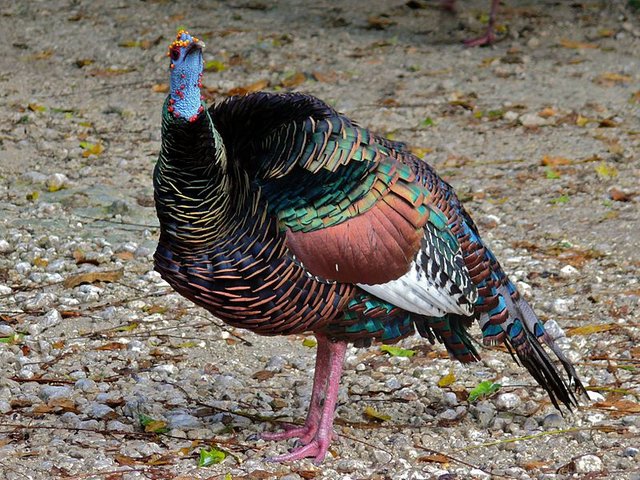Wild Turkeys of North America: The History and Traits of This Native Bird
Once hunted to dangerously low numbers, the wild turkey now thrives in the U.S. and is a fascinating bird to observe in its natural woodland habitat.
Wild turkeys are intelligent, strong and social birds. There are two species in North America: the Common turkey (Meleagris gallopavo), which is found in the U.S. and Mexico; and the Ocellated turkey (Agriocharis ocellata), which inhabits the rain forests of the Yucatan, Guatemala and Belize.
The native Indians of North America relied on wild turkeys for food and used their feathers for decoration and ceremonial purposes. As white men colonized the New World and spread roads and railways, the population of wild turkeys was nearly wiped out by 1900.
The bird was reintroduced not only to its original range, but other places as well, and now can be found in every U.S. state except Alaska, although it is most populous in the East. Only small ranges exist in the Rockies and West Coast states. Wild turkeys in Hawaii are mostly descended from Rio Grande turkeys trapped in Texas in the early 1960s.

Meleagris gallopavo credit
Turkeys are Heavy and Strong Birds
The wild turkey is the heaviest land bird in America, the male reaching up to 24 pounds, which is some 500 times heavier than the average songbird. As omnivores, turkeys eat plants and insects, scavenging for grasshoppers, crickets and beetles along with grass seeds, plant shoots, acorns, chestnuts, fruits and berries. The birds need to build their fat stores for when food is scarce in winter.
Additionally, wild turkeys walk a lot. They have strong legs and toes, and walk about two miles each day searching for food, which also keeps their chest muscles strong for flight. They must eat a lot and be fit to maintain the energy and strength required for their large forms and active lives. Observers notice how flocks of wild turkeys have a network of paths they use to get around and keep to their familiar routes. They are experts at quickly disappearing on foot when disturbed.
Wild turkeys will only fly when they must cross a river or for some other pressing need besides their nightly roosting in trees. Flying up to thick branches above the ground keeps them safe from predators like coyotes, foxes and bobcats.
The Transformation of Male Turkeys in Mating Season
The warty, naked flesh of the wild turkey’s head and neck is colored red and blue, and has droopy wattles. Although it is mostly the males who have beards, some female turkeys are bearded, too. The beard is a cluster of hairlike feathers hanging from the chest.
When mating season begins in the springtime, male turkeys transform. A reddish length of skin on the forehead—called a snood—grows longer and thicker, hanging down over the bird’s face and bill. The wattles on his neck swell bigger and redder, and a fatty mass swells on his chest.
The males also fan out their tails and puff out their feathers in an impressive posture, strut and compete with other males in the territory. Spurs on the back of the male turkey’s legs are used for defense and to establish dominance.
To announce his presence to female turkeys, the male will make a variety of sounds, from the familiar “gobble” to rasping, clucking, whistling, and yelping, which often can be heard over a mile away. These polygamous birds leave the nesting duties to the female, and after the chicks are born, the hens gather with other hens and their broods, and it is these large flocks that people often see foraging in the daytime hours.

Agriocharis ocellata credit
How the Turkey Got Its Name
Early settlers in America probably did not invent the turkey’s name when they became familiar with the native game birds. It most likely occurred back in England, where foreign traders, or “turks,” sold the birds. The English probably called them “turkey birds” and it spread from there. Others claim the name is derived from the sound turkeys make.
Spanish explorers in the 1500s had returned to Europe with turkeys domesticated by Mexican Indians. The colonists then brought over domestic European stock for their farms in the New World. Today, people can distinguish domestic farm turkeys from wild turkeys by their white-tipped tails.
What If the Turkey Had Become a National Symbol?
Benjamin Franklin once wrote that he preferred the turkey to be the U.S. national symbol instead of the eagle, because of the eagle’s unjust behavior of stealing food from other birds.
The turkey’s importance to people today is mainly an important agricultural product and enjoyable food at holiday time. Understanding the wild turkey, apart from the domestic form people consume, is to know how enduring, social and beautiful these birds really are.
Congratulations! This post has been upvoted from the communal account, @minnowsupport, by vermute from the Minnow Support Project. It's a witness project run by aggroed, ausbitbank, teamsteem, theprophet0, and someguy123. The goal is to help Steemit grow by supporting Minnows and creating a social network. Please find us in the Peace, Abundance, and Liberty Network (PALnet) Discord Channel. It's a completely public and open space to all members of the Steemit community who voluntarily choose to be there.
If you like what we're doing please upvote this comment so we can continue to build the community account that's supporting all members.